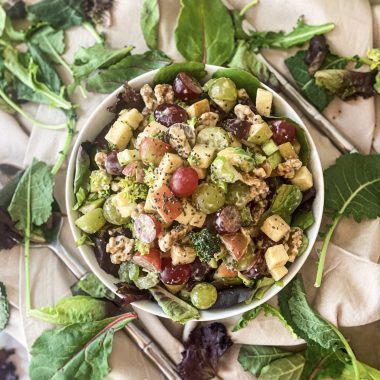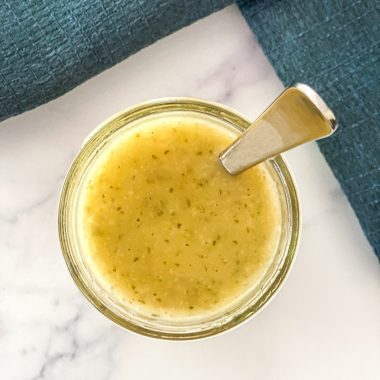What’s the first thing that comes into your head when you think of stocking your salad fridge? Let me guess – some iceberg or romaine lettuce with chicken, cucumber, tomato and a low-fat dressing, right? Maybe you’re more a fan of spring mix or baby spinach with fresh berries and soft cheese. Or perhaps, prepackaged salad mixes are your thing. Honestly, there’s nothing wrong with these choices. I’m happy you’re eating salads.
But personally, I believe in making salads a full-meal deal – that is, a total meal experience (check out “Our Approach” to salad making to learn more). Believe it or not, by stocking your fridge with a good mix of quality salad ingredients you can easily and effortlessly get up to a day’s worth of health-promoting whole foods into a single bowl. Here I’ve compiled a little list of salad fridge staples, that’ll give you plenty of options on hand.
Include Different Types of Leafy Green Veggies
While you don’t necessarily need leafy greens to call something a salad, salads are, without doubt, the absolute best way to get more of them in your diet. So, go ahead and keep your romaine lettuce, spring mix and spinach on the grocery list. Maybe try some others like Swiss chard, butter lettuce and fresh herbs like parsley and cilantro, as they’re incredibly versatile and can add a kick of flavor to practically any salad.
Leafy greens themselves are among the richest sources of fiber, micronutrients and phytonutrients (study up in our “Nutrition Glossary” to learn more). They’re also relatively cheap so grab some different bunches (or packages) to experiment and see which types you like. The darker the leaves, the more nutritious the greens. So, here’s where I’m just going to suggest you move beyond the iceberg lettuce.
There are a few “non-leafy” but green veggies I also suggest keeping in your salad fridge, namely green onions (or scallions), celery and, of course, cucumber. Though not as deeply colored or nutritionally dense, as say kale and broccoli, any one of them can add an extra layer of flavor, freshness and yummy crunch to your salad bowls.
Throw in Plenty of Crucifers for Hearty Texture
Crucifers (or “cruciferous vegetables”) are salad fridge essentials. You might not know them by name, but I’ll bet you’ve eaten a good number of crucifers in your lifetime. Does kale and cabbage ring any bells? How about broccoli and cauliflower? Sound familiar? Though some, like kale and broccoli, can also count as leafy greens, they’re technically classified as crucifers.
Any one of these veggies can add great texture, crunch and a whole lot of nutrition to your salad bowls. Besides being a rich source of antioxidants, when freshly chewed (as you’d do when eating salads), crucifers release powerful cancer-fighting phytonutrients. In addition to the ones I’ve already mentioned, arugula, watercress and radish are excellent for salad making.
Go Beyond Green with a Rainbow of Other Veggies
By now it’s probably clear that I love leafy green veggies and consider them salad fridge essentials. But, as I’ve already said, a salad doesn’t just have to be a big ole’ bowl of green stuff. By all means, bring the full rainbow into your salad fridge. The more colorful the veggies, the more nutrients you’re packing in your salad bowls (visit our “Nutrition Glossary” to learn why).
At the very least, I always keep my fridge stocked with plenty of carrots, beets and bell peppers of all colors (red, orange and yellow). I can easily go through 10-12 bell peppers in a single a week!
Collectively, these veggies are among the richest sources of carotenoids and other powerful antioxidants and phytonutrients that naturally boost immunity and ward off ailments ranging from heart disease to diabetes to the common cold. In addition to their distinctive colors and nutrition, they bring all kinds of unique flavors and textures to a salad bowl.
Add a Few Staples from the “Meat” Group
Unless your diet excludes animal-based foods, feel free to stock your fridge with a few high-quality protein sources like poultry, fish (including shellfish) and even lean meats. In addition to boosting the overall filling effect of your salad bowls, these proteins are collectively rich in good fats, B vitamins and health-promoting antioxidants.
Some of my personal favorites include chopped chicken breast, salmon, shrimp, and occasionally, sirloin. You can also get a good dose of quality protein from plant-based (“meatless”) sources like tofu and tempeh – though many of these products are initially shelved and don’t require immediate refrigeration.
Lay In a Good Supply of Sweet and Tart Fruits
To add a nice variety of rich, indulgent flavors and textures to your salads, always keep a good balance of sweet and tart fruits in stock – this includes tomatoes, which are generally treated as vegetables but technically classified as fruits. Naturally rich in fiber and antioxidants, fresh fruits make for nutritiously delicious toppings and offer a laundry list of health benefits.
Fruits like sweet apples, pears, oranges and strawberries make great sweeteners and can help mask the bitter tastes in some vegetables. To bring in the zing, experiment with tart apples like Granny Smiths, blackberries, raspberries and cherries. The sweet-tart notes of these fruits can be a great complement to more savory salad blends.
Now, I’m not a fan of fruit-centric salads. I generally recommend treating these as desserts. It’s always better to pair fruits with a little fat or protein to keep your blood sugar levels within healthy limits.
Don’t Forget the Complementary Proteins
Of all macronutrients, protein is by far the most filling. This is why I always recommend including a good supply of what I call “complementary proteins” in your fridge. Whole eggs or egg whites, edamame (soybeans) and high-quality cheeses like feta, Gorgonzola and goat cheese are just a few of the complementary proteins that can really power up a salad bowl. I can’t even eat a salad that doesn’t include at least one of them.
So that about sums up my list of salad fridge staples. Hopefully this list leaves you with plenty of good ideas for stocking your own fridge for salads. This is by no means meant to be an exhaustive list, and I’m certainly not suggesting that you go out and buy everything on it. We all have different food preferences and tastes, resources and lifestyles. That’s the beauty of salad making – it can be a great way to express yourself creatively.
Maybe you just want to keep it ultra-simple and stock your fridge with leafy green veggies and meats. Maybe you’re more eccentric (as I am) and have a salad fridge stocked with flamboyant foods. Or, maybe after reading this entire list, you’ve decided to just stick with your pre-packaged mixes. It’s all okay. At the end of the day, it’s all about filling your fridge with foods you enjoy so you can build your own bowls, your own way.







My backyard garden grown onions & peanuts put an extra punch in salads. Looking forward 2 making some of ur salads!
I love it Martin! Can’t wait to see your salad bowls. You’ll have plenty of opportunities to use those onions and peanuts:)